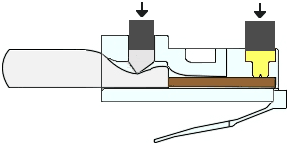LANS SIMPLIFIED. A LAN can be as simple as two computers, each having a network interface card (NIC) or network adapter and running network software, connected together with a crossover cable.
The next step up would be a network consisting of three or more computers and a hub. Each of the computers is plugged into the hub with a straight-thru cable (the crossover function is performed by the hub).
Tools You Need
OK! now we know the tools, lets talk about the cables, we are making cable according to UTP CAT5 Standards.
- Straight-thru cable (PC TO HUB/SWITCH) : Both ends are same.
- Crossover cable (PC TO PC) : Two ends are different
- After striping spread the cable
- After arranging the wires according to Straight-thru or Crossover you must cut off the wire ends to straighten it up.
- After straitening the stripped part should be 1/2"
- Then you thoroughly insert the cable in to the RJ 45 connector.
- After inserting double check the pattern then crimp it. When it's crimped you can't reuse the RJ 45 connector.
COLOR-CODE STANDARDS
Again, please bear with me... Let's start with simple pin-out diagrams of the two types of UTP Ethernet cables and watch how committees can make a can of worms out of them. Here are the diagrams:
Note that the TX (transmitter) pins are connected to corresponding RX (receiver) pins, plus to plus and minus to minus. And that you must use a cossover cable to connect units with identical interfaces. If you use a straight-through cable, one of the two units must, in effect, perform the cross-over function.
Two wire color-code standards apply: EIA/TIA 568A and EIA/TIA 568B. The codes are commonly depicted with RJ-45 jacks as follows:
Cabling Rules
- Try to avoid running cables paralles to power cables.
- Do not bent cable to less than four times the diameter of the cable.
- If you bundle a group of cables together with cable ties (Zip ties), do not over-cinch them. Its okay to snug them together firmly, but don't tighten them so much that you deform the cables.
- Keep cables away from devices which can introduce noise into them. Here's a short list copy machines, electric heaters, speakers, printers, TV sets, fluorescent lights, copiers welding machines, microwave ovens, telephones, fans, elevators, motors, electric ovens dryers, washing machines and shop equipment.
- Avoid stretching UTP cables (tension when pulling cables should not exceed 25 LBS).
- Do not run UTP cable outside of a building. It presents a very dangerous lightning hazard.
Cable tester result












1 comments:
Nice
Post a Comment